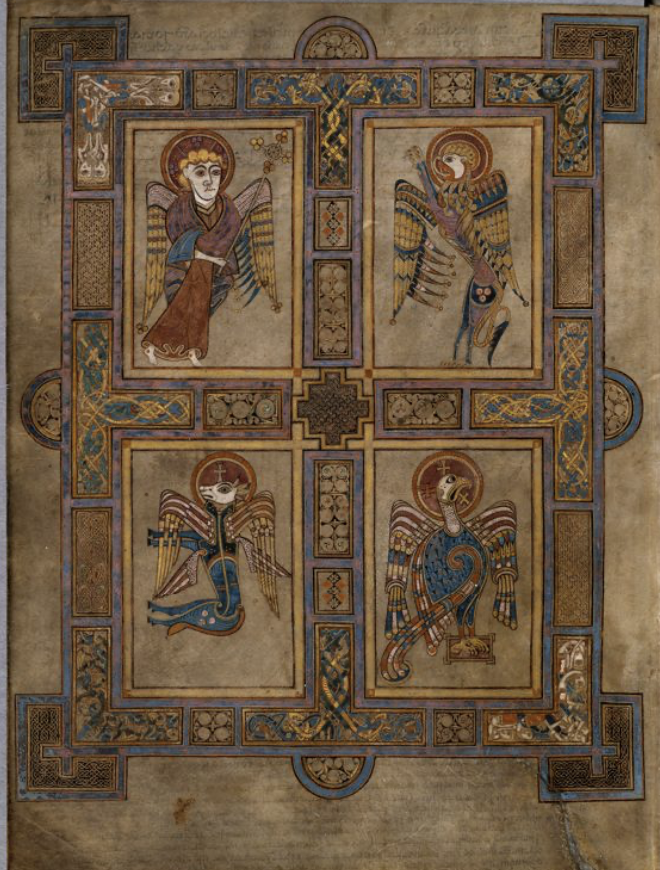
The Evangelists’ Symbols page from The Book of Kells, f.27v. early 9th Century.
The Book of Kells and similar books contain the texts of the four Gospels. Each Gospel is richly embellished with beautiful and intricate decoration and is prefaced by a full page image of the Evangelist and another full page showing all four Evangelists in symbolic form. The page shown here comes from the beginning of the Gospel of Matthew and is preceded by a full page showing only Matthew enthroned. In Christian tradition each Evangelist had his own symbol. Mathew was represented by a man with wings, Mark by a lion, Luke by an ox or a calf and John by an eagle. This symbolism has it origins in two biblical texts. In Ezekiel (1:4-11) the prophet has a vision of four living creatures which are in human form, but with wings. Their faces have four aspects, a man on the front, a lion on the right, an ox on the left, and an eagle on the back. This symbolism appears also the Book of Revelation where four winged creatures surround Christ on his throne (Revelation 4:6-8). The first creature is like a lion. The second is like an ox. The third has the face of a man. The fourth is like a flying eagle. St Irenaeus (130 -202 AD) interpreted these texts as representing the individual evangelists. He said St Matthew was represented by a man, St Mark by a eagle, St Luke by an ox and St John by a lion. Later St Jerome (c.347 -420 AD) also assigned the ox to St Luke and the man to St Matthew, but he differed from St Irenaeus in giving the the lion to St Mark and the eagle to St John. It is St Jerome’s symbolic scheme which has prevailed in later manuscripts and in Western Art. A page such as this one has the four different symbols but is also a strong statement of the intrinsic unity of the four Gospels. The Book of Kells and other similar books drew the readers attention to this unity by including tables showing the parallel texts with the Gospels. Yet the individual character of each gospel was not to be forgotten: it was to be celebrated. In this sense these manuscripts are an extraordinary and beautiful celebration of the richness of the scriptures. Gregory the Great related each of these symbols to Christ stating that Christ was a man when he was born, a calf in his death, a lion in his resurrection, and an eagle in his ascension to heaven. Of course, the unity of the Gospels is in their common witness to Christ under the inspiration of the Holy Spirit. The cross of Christ is there too in the ornate framing of the Evangelists’ symbols. The richly and intricate decoration of these borders includes snakes, peacocks, stags, goats, doves, wolves, hares, cats, chalices, panthers and fish as well as chalices vines and grapes, evoking the manifold workings of the Holy Spirit in the whole of creation. These monks embraced the Word of God and in these books gave visual expression to its richness and colour, its unity in diversity. Above all, by painstakingly preserving the Word in such an exquisite and beautiful form, they remind us of the precious and life-giving gift we have received from the Evangelists and, through them, from on high.
The Catholic Chaplaincy serves the students and staff of the University of Edinburgh, Edinburgh Napier University and Queen Margaret University.
The Catholic Chaplaincy is also a parish of the Archdiocese of St Andrews and Edinburgh (the Parish of St Albert the Great) and all Catholic students and staff are automatically members of this parish.